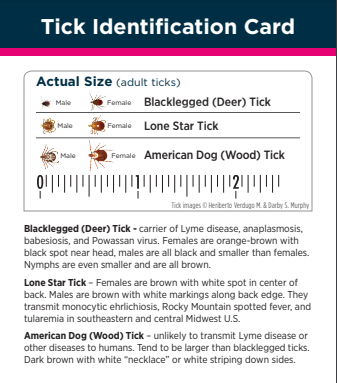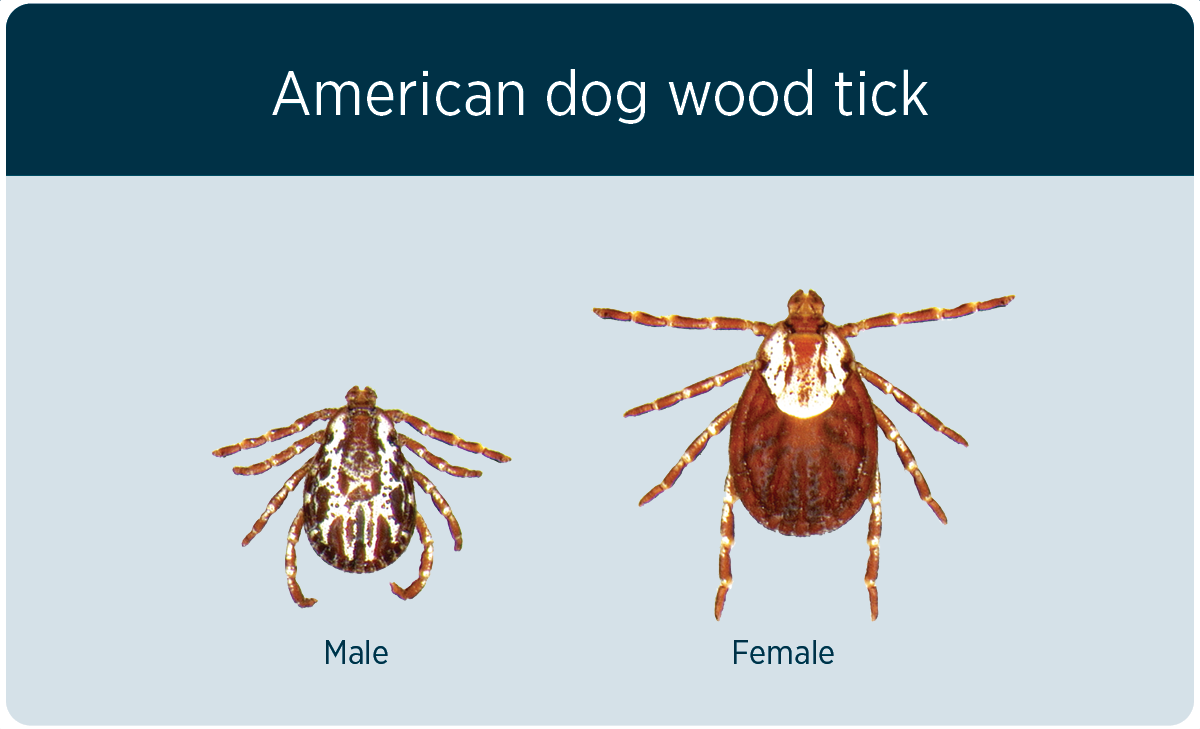Tick-borne illnesses such as Lyme disease, anaplasmosis and babesiosis are becoming more common across Wisconsin as the population of ticks like the blacklegged and lone star tick increase.

When is tick season in Wisconsin?
Ticks are on the move in Wisconsin from spring until well into fall, depending on how warm the weather is.
Marshfield Clinic researchers are working with state and federal authorities to learn more about tick habitat and spread of tick-borne diseases.
Where are ticks found in Wisconsin?
If you live or play in wooded areas, near areas with tall grasses or habitat popular with woodland creatures, ticks that carry disease may abound.
Changes in forestry practices and increases in deer and white-footed mouse populations, which host the ticks, have led to increased prevalence of ticks. Also, ticks are being found farther north than before thanks to changing patterns that keep weather warmer longer.
“Weather, temperature, rainfall patterns are changing and ticks can better survive over the winter,” according to Jennifer Meece, Ph.D., who has been studying ticks and tick-borne illnesses for many years as a researcher at Marshfield Clinic Research Institute. The Research Institute has been actively involved in tick-borne disease research since the 1990s.
Hikers, hunters and farmers are at the highest risk as they brush up against vegetation where ticks reside, but anyone who spends time outdoors, including in their yards, may potentially be at risk in Wisconsin.
“Tick-borne diseases were once primarily a problem in western and northern Wisconsin,” said Anna Schotthoefer, Ph.D., a researcher at the Research Institute. “Just in the past 10 to 15 years, we’ve seen ticks spread across the state so that now cases of tick-borne illnesses are being reported from every county.”
Illnesses from mosquito, tick and flea bites more than tripled in the United States from 2004 to 2016, according to the Centers for Disease Control and Prevention, and new emerging diseases are being detected.

How to protect yourself from ticks
Reducing your exposure to ticks is the only way to avoid tick-borne diseases.
Protect yourself from all ticks for all reasons by:
- When possible, avoiding dense wooded areas and areas covered with tall grass.
- Wearing light-colored clothing, including long sleeves and tall socks, which covers all your skin, so you find ticks before they attach to your skin.
- Doing self-checks every time after outside activities. Have a friend or family member check you for ticks and vice versa.
- Using a repellent, preferably containing DEET, picaridin, IR3535 or oil of lemon eucalyptus, to repel ticks and mosquitoes.
- Removing ticks promptly.
- Buying clothing, footwear and outdoor gear pre-treated with repellent containing permethrin.
- Protecting pets. Use a tick or insect repellent. In animals, symptoms may not be present for seven to 21 days. Monitor your pet closely and do full-body checks.
“It is important not to be afraid of the outdoors,” Dr. Meece said. “Be outdoors, but use common sense to protect yourself, your family and your pets.”
Types of ticks in Wisconsin
Wisconsin is home to at least 16 species of ticks, but it is just a couple of known species that prey on humans and are disease carriers.
“We are in the Midwest epicenter for Lyme disease, anaplasmosis and babesiosis,” said Dr. Meece.
Blacklegged (deer) tick
Blacklegged or deer ticks are no larger than a sesame seed as a juvenile and only slightly bigger as an adult. Males are all black while females are dark brown to reddish-orange in color with a dark patch on their upper bodies.
Blacklegged or deer ticks are the primary ticks that transmit Lyme disease, anaplasmosis, babesiosis and Powassan virus.
You can find blacklegged or deer ticks across the state.
Lone star tick

Females are brown with a white spot in the center of their back. Males are brown with a white marking along the back edge.
Lone star ticks transmit human monocytic ehrlichiosis (HME) and tularemia. Some people bitten by this tick also develop a food allergy to red meat called alpha-gal syndrome.
You can primarily find Lone star ticks in the southeastern and central Midwest.
American dog wood tick

Tend to be larger than blacklegged ticks. They are dark brown with white “necklace” or white striping down sides.
The American dog wood tick transmits Rocky Mountain spotted fever to humans.
You can find American dog wood ticks across the state.
Common tick-borne illnesses in Wisconsin
Cases of Lyme as well as anaplasmosis and babesiosis are increasing as the blacklegged tick moves from west to east across Wisconsin.
Lyme disease
Lyme disease is transmitted to humans through the bite of a blacklegged tick. Symptoms are fever, headache, fatigue, joint pain, swelling and skin rash known as erythema migrans. It sometimes starts with a bulls-eye or dusky red, round rash followed by flu-like illness. Lyme disease commonly progresses to severe fatigue, joint pain and swelling, among other symptoms, if not treated early. A doctor can treat most cases with antibiotics.
Anaplasmosis
Anaplasmosis is transmitted to humans through the bite of a blacklegged tick. Symptoms are fever, headache, muscle aches, chills, nausea, vomiting, joint pain, fatigue and in rare cases, skin rash. A doctor can treat most cases with antibiotics.
Babesiosis
Babesiosis is transmitted to humans through the bite of a blacklegged tick. People sometimes do not experience any symptoms with babesiosis. When there are symptoms, they include fever, chills, sweats, headache, body aches, fatigue and anemia. A doctor can treat most cases with antibiotics.
Powassan virus
Powassan virus is transmitted to humans through a tick bite. Many people who become infected do not have symptoms. Symptoms, though, can include fever, headache, vomiting, weakness, confusion, loss of coordination, speech difficulties and seizures. Those with severe illness often need to be hospitalized to get support with breathing and swelling in and around the brain. About half of survivors have permanent neurological symptoms, like recurrent headaches, muscle wasting and memory problems. About 10% of virus encephalitis cases, where there is infection in the brain, are fatal. There is no vaccine or antiviral drug treatment, yet.
Human monocytic ehrlichiosis (HME)
HME is transmitted to humans through the bite of a lone star tick. Symptoms include fever, headache, muscle aches, fatigue, rash (in some cases), nausea, coughing diarrhea and abdominal pain. If left untreated, it can lead to death. A doctor can treat most cases with antibiotics.
Rocky Mountain spotted fever
Rocky Mountain spotted fever is transmitted to humans through the bite of a dog wood tick. Symptoms include fever, headache, muscle aches, nausea, vomiting, abdominal pain and joint pain. A rash can form that starts as small red spots on the wrists, ankles and feet, spreading to the rest of the body. A doctor can treat most cases with antibiotics.
Tularemia
Tularemia can be transmitted to humans through the bite of a tick, but also through the bite of a deer fly; infected animal contact; ingestion of contaminated food or water; or inhalation of contaminated soil or dust. Symptoms include fever, skin ulcers, swollen lymph nodes, sore throat, cough, chest pain, muscle aches and fatigue. A doctor can treat most cases with antibiotics.
Tick-borne illness detection
Fortunately, medical research has led to quicker and improved tick-borne illness diagnoses that help patients get proper treatment and return to better health sooner.
When a tick bites it can potentially transmit disease through its saliva. A person bitten by a deer tick might not see symptoms for several weeks, and even then the symptoms might be dismissed.
Clinic providers can order tests that can help detect the infections.
“Symptoms, which include acute fever, are very similar to those of influenza,” said Dr. Meece. “For providers seeing a patient, if they have these symptoms in winter, they will suspect it is flu. In summer, it is quite possibly anaplasmosis.”
Researching the next tick-borne illness tests
As the Wisconsin population of deer ticks expands and spreads, Marshfield Clinic researchers continue to look for ways to more quickly identify tick-borne diseases like Lyme disease, anaplasmosis and babesiosis.
They have turned to molecular tests that focus on DNA, the genetic code found in all living things. But in this case, it is not human DNA, as you might expect, but rather the DNA of the infecting organisms.
“While we still use a traditional antibody test for Lyme disease, we now also offer DNA-based tests for anaplasmosis and babesiosis,” said Dr. Schotthoefer. “These tests are more sensitive, rapid and offer a definitive answer for either the presence or absence of the infecting organism.”
Dr. Schotthoefer and other members of the Integrated Research and Development Laboratory at the Research Institute have collaborated with Marshfield Labs on several tick-borne disease studies that have resulted in new test development.
Researchers are working to develop a reliable diagnostic test that detects the DNA of the bacterium that causes Lyme disease. Lyme disease is the most common and well-known of the three tick-borne diseases in Wisconsin, but it is often difficult to identify because symptoms vary and do not appear until days or sometimes months after a tick bite.
Monitor your health closely after any tick bite, Dr. Meece said. And, talk with your doctor if you develop a rash, fever, headache, joint or muscle pain or swollen lymph nodes within 30 days after a tick bite.
You may be able to help
If a doctor diagnoses you with early stages of Lyme disease and live in the Midwest, you may be able to participate in research at the Research Institute to help develop better tests and treatment for Lyme disease. For more information, contact the Research Institute at 715-389-5738.
For questions about ticks, talk to a Marshfield Clinic Health System provider.
Schedule appointment Message your provider
Related Shine365 articles
Wisconsin bug bites and bee stings: Prevention and treatment







Leave a Reply